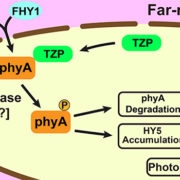
A New Player In Plant Respose to Far-red Light
Research, The Plant Cell, The Plant Cell: In a NutshellZhang et al. discover a protein that interacts with the photoreceptor phyA and plays a role in plant response to far-red light. Plant Cell https://doi.org/10.1105/tpc.17.00677
By Shaoman Zhang, Cong Li and Jigang Li
Background: Far-red (FR) light, corresponding to 700- to 750- nm wavelengths…
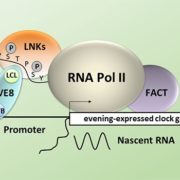
How Plants Generate Circadian Rhythms in Transcription
Research, The Plant Cell, The Plant Cell: In a NutshellMa et al. investigate a protein complex that controls steady-state mRNA circadian oscillations https://doi.org/10.1105/tpc.18.00052
By Yuan Ma, Sergio Gil, Klaus D. Grasser and Paloma Mas
Background: Circadian clocks are internal time-keeping mechanisms that help organisms to adapt to the…

B-GATAs Fine Tune Greening
Research, The Plant Cell, The Plant Cell: In a NutshellBastakis et al. investigate control of the greening process in Arabidopsis https://doi.org/10.1105/tpc.17.00947.
By Emmanouil Bastakis
Background: The greening of the plants is based on the synthesis and accumulation of the chlorophylls, which takes place in chloroplasts. Chlorophylls capture…

Protein Editing for Multi-Tasking
Research, The Plant Cell, The Plant Cell: In a NutshellZauner et al. investigate the mechanism of protein re-purposing. The Plant Cell (2018). https://doi.org/10.1105/tpc.17.00963.
By Florian B. Zauner, Elfriede Dall and Hans Brandstetter
Background: Plants cannot run away from herbivores, drought, or heat. To withstand adverse conditions, plants have…
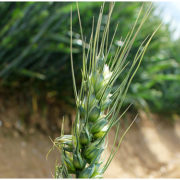
TEOSINTE BRANCHED1 and Wheat Inflorescence Architecture
Research, The Plant Cell, The Plant Cell: In a NutshellDixon et al. (2018) investigate the regulation of wheat inflorescence architecture by TEOSINTE BRANCHED1. Plant Cell https://doi.org/10.1105/tpc.17.00961
Background: Grass inflorescences are composed of many seed-producing flowers (or florets) that are arranged on branches called spikelets. The number…
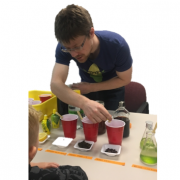
Exploring plant chemistry with a red cabbage pH indicator: Rainbows of color via plant chemistry
Blog, EducationA hands-on activity posted by Lucas Busta @PlantsRChemists
In this activity, participants will work with test tubes of red cabbage juice to determine the pH of various other (plant-based) liquids and solutions. It's a fun activity for all ages - even if participants are too young to understand acid/base…
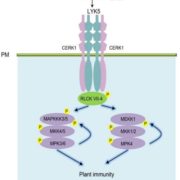
A new mechanism for plant immune pathways discovered by genetics
Blog, The Plant Cell: NewsSource: Institute of Genetics and Developmental Biology Published: 2018-07-05 http://www.cas.cn/syky/201807/t20180704_4657121.shtml (Translation by Google Translate)
Plants sense the presence of pathogens through pattern recognition receptors (PRRs ) located on the surface of the cell membrane to…
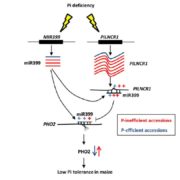
The PILNCR1-miR399 regulatory module is important for low-phosphate tolerance in maize (Plant Physiol.)
Plant Science Research WeeklyNearly ten years ago, microRNA 399 (miR399) was recognized as a regulator of phosphate (Pi) homeostasis. miR399 expression is induced upon low Pi conditions, and, in Arabidopsis, rice, soybean and barley, miR399 suppresses PHO2, a negative regulator of Pi uptake. Du, Wang, Zou et al. found that contrary…
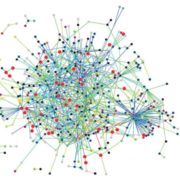
Bioinformatics core competencies for undergraduate life sciences education (PLOS One)
Plant Science Research WeeklyUndergraduate life science curricula need to incorporate training in bioinformatics. Wilson Sayres et al. surveyed 1260 faculty from across the US to identify their thoughts on what such training should involve. Not surprisingly, 95% of those surveyed agreed with the statement “I think bioinformatics…

